For this recipe, we went all natural: earth colorants and a soothing blend of rosemary, lavender and eucalyptus essential oils make this soap a raw beauty. We were very excited to incorporate our brand new natural Indigo Powder colorant into this soap and it turned a beautiful blue-grey in the finished product. Handmade soap with indigo provides a great contrast to the Paprika, which turned a lovely orange, and the Safflower Powder, which turned a soft yellow. The spoon plop is also an easy technique that yields intriguing results every time.

What You’ll Need:
11 oz. Coconut Oil
2.2 oz. Mango Butter
13.2 oz. Olive Oil
11 oz. Palm Oil
6.6 oz. Sweet Almond Oil
6.1 oz. Sodium Hydroxide
14.5 oz. distilled water
1.1 oz. Rosemary Essential Oil
1.1 oz. Eucalyptus Essential Oil
.6 oz. 40/42 Lavender Essential Oil
Click here to add everything you need for this project to your Bramble Berry shopping cart!
If you’ve never made Cold Process soap before, stop here! I highly recommend checking out our FREE four part SoapQueen.tv series on Cold Process Soapmaking, especially the episode on lye safety. And if you’d rather do some reading, Bramble Berry carries a wide range of books on the topic, including my newest book, Soap Crafting. You can also checkout the digital downloads for that instant gratification factor.
SAFETY FIRST: Suit up for safe handling practices! That means goggles, gloves and long sleeves. Make sure kids, pets, and other distractions and tripping hazards are out of the house or don’t have access to your soaping space. Always soap in a well-ventilated area.
COLOR PREP: Disperse 1 teaspoon all colorants into 1 tablespoon of liquid oil (we like Sweet Almond or Sunflower). Prepping your colors in the beginning will allow you to work quickly and give you more time to work with your soap. Use the mini mixer to get all those clumps worked out smoothly.
FRAGRANCE PREP: In a glass container, combine the Rosemary, Eucalyptus and 40/42 Lavender Essential Oils. Set aside.
ONE: Slowly and carefully add the lye to the water, and stir until clear. Set aside to cool. If you’d like a harder bar of soap, you can add Sodium Lactate to the cooled lye water. Use 1 teaspoon of Sodium Lactate per pound of oils in the recipe.
TWO: Then, melt and combine the Coconut Oil, Mango Butter, Olive Oil, Palm Oil and Sweet Almond Oil in a large glass container. Once the lye water and the oils have cooled to 130 degrees or below (and are ideally within 10 degrees of each other), add the lye water to the oils and stick blend until thin trace.
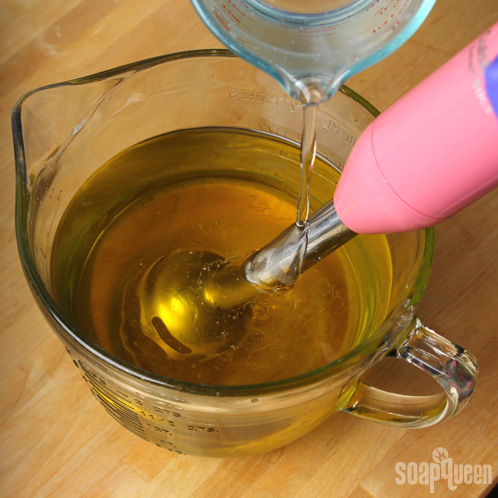

THREE: Equally split the batter into three containers.

FOUR: Add one colorant per container in the following measurements:
- 3 teaspoons dispersed Indigo Powder
- 3 teaspoons dispersed Paprika
- 3 teaspoons dispersed Safflower Powder + 1 teaspoon Titanium Dioxide
Mix in the colorants using a wire whisk or spoon.

FIVE: Split the essential oil blend equally between the three containers and stir in with a wire whisk or spoon.

SIX: Use a large spoon (we like our Round Silicone Spoon) to plop spoonfuls of color into the mold. Repeat this process with each color, keeping the same color order, until you have about 1/5 of the soap remaining in the cups.

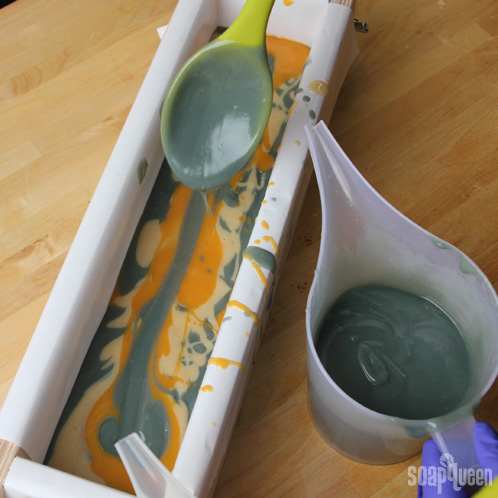
SEVEN: Using the remaining soap in the cups, pour lines of soap horizontally into the mold.

EIGHT: Insert a chopstick or dowel about 1/4″ into the soap and make a vertical zig-zag pattern down the length of the mold for that finishing touch swirl.

NINE: Using your chopstick or dowel again, make a series of small loops down the length of the soap. Once you’ve gone from one end of the soap to the other, make small loops back down the length of the mold. When you reach the end of the mold, create one big loop that carries you into the next row, and do a reverse loop back across the mold again. You may recognize this swirling technique from the Elemental Swirl.


Spray the entire top with 91% Isopropyl Alcohol to reduce soda ash. It is particularly important to insulate this soap for 24 hours because gel phase will help bring out a nice, vibrant color in the Indigo. Unmold after 3-4 days and allow to cure for 4-6 weeks. Enjoy!


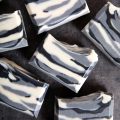
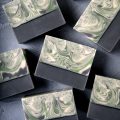
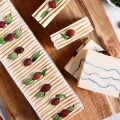
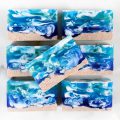
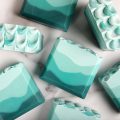
hello. does the indigo stain? I’ve been reading up on natural colorants and saw a cple site where they mentioned that indigo might stain washcloths, etc. someone mentioned adding it to the lye water, but when trying to figure out how to do that when i’m making a swirl made my head whirl lol. have ya’ll found staining to be an issue?
Hello Anne-Marie,
Can this recipe be used to make CPOP? The hot process is my favorite process.
Thank you,
Laurie
I made a 1/2-size batch of this soap, not knowing what to expect from the fragrance or the technique. (Also because I don’t have a 4-pound mold.) I followed the instructions to the letter, and I’m happy to report that my soap looks exactly like your pictures!! I’d post some photos, but I was sold out in the first few minutes of my show. My customers love the colors, the fragrance (my husband says it smells like his dad’s wood shop), and the super-cool swirl pattern. Thank you, Team Brambleberry! My next purchase is going to be a 4-pound mold. 🙂
Hi Gretchen!
We are so excited that this soap turned out so great for you. If you ever do get a chance, be sure to share the pictures on Bramble Berry’s Facebook page, we’d love to see them.
https://www.facebook.com/BrambleBerry
Happy Soaping!
-Becky with Bramble Berry
Dear Anne-Marie,
My question is about using sodium lactate in a recipe, I haven’t used it before. Sodium lactate I found here is in liquid form, is it the form used in soaps? and if yes, I read that you recommend 1 teaspoon ppo, should I add it to the oils or right before trace?
My second question is if table salt would do the job of sodium lactate? ie keeping the soap firm and harder? If yes, what would be your recommendation in terms of amount and how to use?
Many many thanks,
Pelin
Good morning, Pelin!
Sodium Lactate is a liquid salt that is naturally derived from the natural fermentation of sugars found in corn and beets. The kind that you are referring to is the kind you can use in soaps! We suggest using it at a rate of .5% – 4%, or 1 tsp per pound of oils. We actually add it to our water phase (cooled lye water), when making cold process recipes.
Sodium Lactate: https://www.brambleberry.com/Sodium-Lactate-P5127.aspx
If you don’t want to use Sodium Lactate, you can actually use a salt-water solution, which you can find an example of in this blog post:
Palm Free Vertical Twist Tutorial: http://www.soapqueen.com/bath-and-body-tutorials/cold-process-soap/palm-free-vertical-twist-tutorial/
We suggest mixing in 4 teaspoons of regular table salt in 4 ounces (by weight) of warm water. Stir until the salt is fully dissolved. I hope that this helps! 🙂
-Becky with Bramble Berry
Thanks Becky!
So I understand I dissolve salt in warm water and then prepare the lye solution with this salty water. Is it correct?
Hi Pelin!
You would take about 4-5 ounces of the called for liquid (distilled water) in your recipe and prepare the salt water solution. Once your lye water and oils have been mixed, you can then add that salt water solution that you prepared. I hope this makes sense!
If you are using the Sodium Lactate, you would add that to your lye water solution.
-Becky with Bramble Berry
I was wondering would salt have any effect on the pH level of the soap, as I ended ip with a slightly higher pH level than usual. Thanks,
Hi Pelin, in response to your question, “I was wondering would salt have any effect on the pH level of the soap, as I ended ip with a slightly higher pH level than usual. Thanks,”
The salt added to your soap should not have a large effect on the pH of your soap. Chemically speaking, salt is a base compound, falling smack in the center of the acid-alkaline spectrum.
Hope this helps!
-Amanda with Bramble Berry
Have to laugh at myself! I made this, and it doesn’t look anything like the pictures – more like I did plain layers! It’s very nice and even, but I don’t think I’ve quite grasped the concept yet. Maybe I’m just too neat? (That’s like saying maybe Christmas happens in July – answer is probably not!)
Hi Carly!
You can totally get this technique down, and it does take a bit of practice. We’d love to see how your soaps are turning out and if you get a chance, you can share your photos on Bramble Berry’s Facebook page. =)
Happy Soaping!
-Becky with Bramble Berry
https://www.facebook.com/BrambleBerry
I just placed my order to make this soap and I am so excited! My only concern, however, is that it says advanced, and I am a very new soaper. So I don’t expect mine will turn out quite like these pictures, but I know I will have fun regardless!
Thanks for all the great tutorials, especially the all-natural soaps. Please keep them coming.
Hi Megan!
Just remember to follow all the directions, make sure you supplies and tools are nearby. You can also check out this blog post to make sure you are up-to-speed on what may happen during a cold process soaping process:
Free Beginner’s Guide To Soapmaking: Cold Process: http://www.soapqueen.com/bath-and-body-tutorials/cold-process-soap/free-beginners-guide-to-soapmaking-cold-process/
Be sure to let us know how it goes, and if you get any pictures, you can share them with us on Bramble Berry’s Facebook page.
https://www.facebook.com/BrambleBerry
-Becky with Bramble Berry
I can’t wait to try this! Love the tutorial! 🙂 Thanks!
Hi Becky!
We are so excited for you to try it as well. Be sure to let us know how it turns out for you! =)
-Becky with Bramble Berry
Great tutorial! Will the paprika and safflower retain their color or eventually go brown? How does the indigo hold up?
Hi Nikki!
These colorants aren’t going to go brown, but because they are a natural colorant they may fade a bit over time. The Indigo Powder holds up great and we just can’t stop using it in our batches! We hope you get a chance to try it out. =)
Happy Soaping!
-Becky with Bramble Berry
Natural Indigo Powder: https://www.brambleberry.com/Natural-Indigo-Powder-P5727.aspx
Cannot wait to try this! I got my indigo powder last week, and have been debating what to try it in; I think this is it!
Hi Carly!
We can’t wait for you to try this project, you will just love the all-natural colorants and how they turn out. =) If you get any pictures, be sure to share them with us on Bramble Berry’s Facebook page.
https://www.facebook.com/BrambleBerry
-Becky with Bramble Berry
So I made the soap, and I have no idea what went wrong, but my paprika colored part totally faded and you can barely tell that there’s any color in those areas! My soap itself was 80% olive oil and 20% coconut oil – would that have caused the problem? Super sad, because I loved the EO’s that I put in (lavender, sage, bergamot) and the indigo powder part turned out so pretty!
Silly question but did you use the exact same amounts of color in the the recipe – and was the recipe you made the exact same size? The colorant shouldn’t have been affected by the soap recipe itself but did you go through gel phase? That can affect it too.